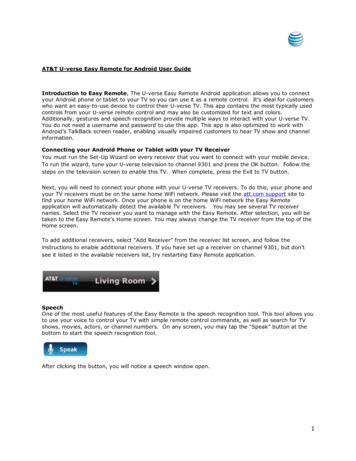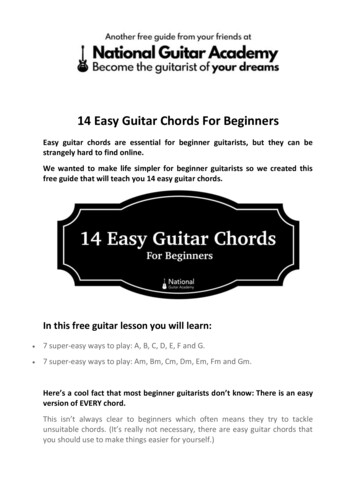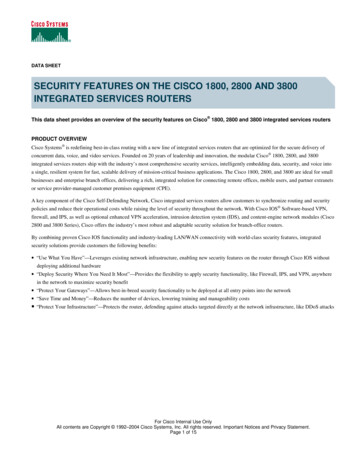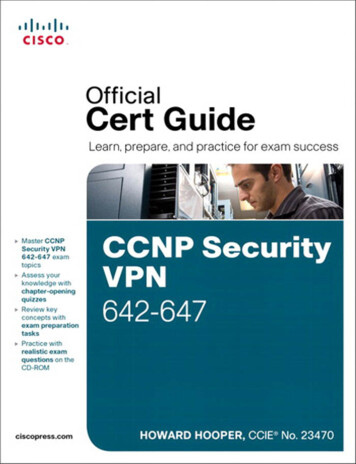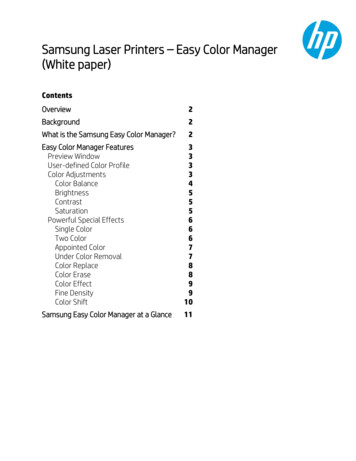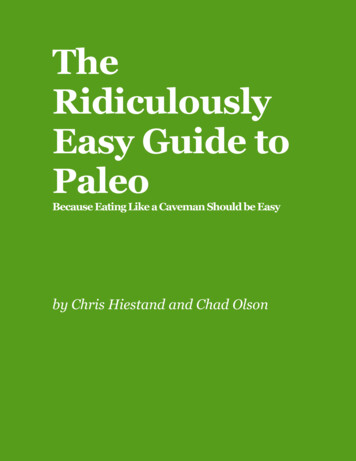
Transcription
TheRidiculouslyEasy Guide toPaleoBecause Eating Like a Caveman Should be Easyby Chris Hiestand and Chad Olson
THE RIDICULOUSLY EASY GUIDE TO PALEOTable of ContentsPart 1 – Why Paleo?. 7Defining Your “Why”. 8What is the Paleo Diet?. 9The Many Benefits of Paleo.10What's wrong with food today?.11Basics of the Paleo Diet. 13Part 2 – Getting Started with Paleo .14Getting Started. 15Step One – Get Rid of the Junk.15Step Two – Re-Stock! . 15Making Paleo Affordable. 18Step Three – Plan Your Meals.22How Much Should I Eat?. 23Part 3 – Living the Paleo Lifestyle.25Taking Care of Yourself . 26Move Around Caveman Style.26Run Really Fast. 26Lift Heavy Stuff. 27Engage in Low Impact Play.29Get Some Sun!. 29Sleep Like a Caveman. 32Reduce Stress . 35Reasonable Splurging. 35Make Cooking Fun . 372
THE RIDICULOUSLY EASY GUIDE TO PALEOSupplements and Paleo. 39What to do When You Goof Up.40Closing Thoughts. 413
THE RIDICULOUSLY EASY GUIDE TO PALEODisclaimerThe ideas, concepts and opinions expressed in this book areintended to be used for educational purposes only. This book isprovided with the understanding that authors and publisher are notrendering medical advice of any kind, nor is this book intended toreplace medical advice, nor to diagnose, prescribe or treat any disease,condition, illness or injury.It is imperative that before beginning any diet or exercise program,including any aspect of the PrimalPal system or PrimalPal programs,you receive full medical clearance from a licensed physician. Author andpublisher claim no responsibility to any person or entity for anyliability, loss, or damage caused or alleged to be caused directly orindirectly as a result of the use, application or interpretation of thematerial in this book. 2012, PrimalPal LLC. All rights reserved.Except as permitted under the United States Copyright Act of 1976,reproduction or utilization of this work in any form or by anyelectronic, mechanical, or other means, now known or hereafterinvented, including xerography, photocopying, and recording, and inany information storage and retrieval system, is forbidden withoutwritten permission of PrimalPal LLC.To learn more about the PrimalPal system please visitwww.primalpal.net.Publisher: PrimalPal LLC7760 France Ave. S.Suite 1100Bloomington, MN 554354
THE RIDICULOUSLY EASY GUIDE TO PALEOIntroductionFrom Chris Hiestand and Chad Olson, the founders of PrimalPaland authors of The Ridiculously Easy Guide to PaleoWe are super pumped that you’re here! By reading this guide to Paleoyou are investing in your health. We think that’s awesome, and we’rehonored to represent the Paleo community with our eBook and withPrimalPal, an online Paleo meal planning application that makesfollowing a Paleo diet ridiculously easy.You may be curious about the benefits of Paleo, such as: Increased energy Weight loss Improved cholesterol levels Enhanced athletic performance Better sleep Recovery from conditions such as GERD, IBS and sinusproblems Exceptional mental clarity Improved mood and decreased anxietyThis is not a random list of results we’ve just read about. The benefitsabove represent what we have personally experienced or elsewitnessed in people close to us. And there are many more not listedhere!We made this FREE resource because we believe that Paleo canhelp you achieve ultimate health, and it shouldn’t be so timeconsuming to figure out how to make it happen.You probably noticed that the Paleo world is overflowing withinformation. This is great, unless you have a limited amount of time tosearch through all the resources and implement the best ideas.Sadly, the vastness of information can be so overwhelming that it stopssome people from even starting. We know, because we wereintimidated too. Enter: The Ridiculously Easy Guide to Paleo.5
THE RIDICULOUSLY EASY GUIDE TO PALEOThe Ridiculously Easy Guide to Paleo is designed to introduce theessentials of Paleo in one, easy-to-understand resource.We made this guide for people who want to learn the basics quickly andstart taking action. Before making this FREE resource, we found itdifficult to share our favorite helpful Paleo information with friendsbecause it was all over the place. So many blogs and books, so littletime!In The Ridiculously Easy Guide to Paleo we’ve done the legwork foryou and combined the best information into this simple eBook.Once you’ve devoured the content, share with your friends and family!They’ll appreciate the simplicity of this guide as opposed to 100 weblinks or 200-page books to get up to speed.We hope that after reading this, you are ready to create a lifestyle. Letus know about your commitment to Paleo by 'liking' us onFacebook and joining the PrimalPal community.We also invite you to join our community of Paleo Lifestylers atwww.primalpal.net and sign up for a 10-day free trial of our Paleo mealplanning application. We built PrimalPal because eating like acaveman should be easy. Use it to save time and money, and get onwith living the ultimate healthy lifestyle!Good luck on your Paleo quest, and enjoy being the healthiest version ofyou!Chris & Chad6
THE RIDICULOUSLY EASY GUIDE TO PALEOPart 1 – Why Paleo?“In health there is freedom. Health is the first ofall liberties.”-Henri Frederic Amiel“Time and health are two precious assets thatwe don't recognize and appreciate until theyhave been depleted.”-Denis Waitley7
THE RIDICULOUSLY EASY GUIDE TO PALEODefining Your “Why”When you’re making a lifestyle change, such as changing the way youeat, it’s essential that you take the time to calibrate your values andbeliefs. Without understanding your own values for your health youcannot be successful.We subscribe to the belief that if you have a strong enough “why,” you’llfind the “how” to achieve anything. When finding your unique “why,” it’simportant to acknowledge that behavior is driven by the need to avoidpain and the desire to gain pleasure.Avoiding physical pain is a biological mechanism that keeps us alive.But many times we experience more perceived pain than actualphysical pain, and for most people the desire to avoid pain will alwaystrump the desire to gain pleasure. Learning how to control what youlink to pain and pleasure is essential to making a successful life change.Here’s a brief exercise to get you thinking in the right direction:We recommend downloading the exercise worksheet that is availableon the resource website. (Password: ilovepaleo)Start by writing down at least one action that you need to take toimprove your health. It could be cleaning out the pantry, eating morevegetables, exercising every day or planning your weekly meals.Whatever it is, write it down.Once you’ve written that one thing down, follow this four-step processto get yourself into the mindset of taking action toward this goal:1.Write down the pain that’s keeping you from taking action.2.Write down the pleasure you get from NOT taking action andNOT following through.3.Write down what it’s going to cost you if you don’t change.4.Write down what you will gain from taking action andfollowing through.Be honest with yourself. What will inaction cost you in two years, orfive years, then the next 10 years? Don’t hold back. Get to the pointwhere your focus is directed towards how painful not taking action willbe and how pleasurable the result will be from following through.8Why do you want tobe healthier?If you ever findyourself avoidingshort-term challengesand sabotaging yourhealth, remindyourself why you’re onthe Paleo journey andrecommit to yourself.
THE RIDICULOUSLY EASY GUIDE TO PALEOSo this brings us back to the original question: Why do you want to behealthier?Maybe you thought about how your life would be affected by extraweight, less energy, Type 2 diabetes, having a heart attack or a stroke.Maybe you want to witness all of the milestones your children willachieve. Maybe your kids are overweight and unhealthy. Maybe youwant to turn heads at the beach or set a better example for your kids sothey can live long, healthy lives.Whatever your “why” is, write it down and keep it somewhere handy. Ifyou ever find yourself avoiding short-term challenges and sabotagingyour health, remind yourself why you’re on the Paleo journey andrecommit to yourself. Use this “why” to create a powerful and positivechange in your life!Now you can now focus on the “what” and “how” by getting started withthe Paleo diet. We’ll spend some time defining Paleo and then move onto implementing the changes that are going to make your “why” areality.What is the Paleo Diet?The Paleo Diet, simply put, mimics the eating habits of our Paleolithicancestors, hence the name “Paleo” diet. Our early human ancestorswere hunters and gatherers, foraging for plants and animals. The idea isto consume food as our ancestors did approximately 10,000 years ago,when they ate natural foods like meat, fish, fowl, tubers and roots,fruits, leaves, nuts, and other plants. These are the foods that we weredesigned to eat through evolution for optimal human function.The term “Paleo” is one name for this approach to diet and lifestyle, butthere are many more titles and slight variations to each approach. Somepeople get caught up in a particular brand or term.We’re not picky about which one(s) you adopt – we tend to use many ofthem interchangeably ourselves. So whether you choose Paleo,Archevore, Primal, Ancestral, Evolutionary or Whole Food as long asyou emphasize the right types of food and lifestyle decisions, that’sgreat.We will use the term Paleo throughout this book for the sake of ease,not because we have some pseudo-religious tie to the term itself.9
THE RIDICULOUSLY EASY GUIDE TO PALEOSo why should we try and emulate an ancestral way of eating?Archeological and anthropological data suggests that our preagricultural ancestors were largely free from modern afflictions ofwesternized cultures including obesity, cancer, and cardiovascular andautoimmune diseases. We don’t know about you, but we’d like to avoidthese things.But avoiding bad future health isn’t the only benefit to eating like ourancestors. Read on for more awesome Paleo benefits.The Many Benefits of PaleoWe can all agree that our health and wellbeing are the foundation for ahappy life. Here are some of the most commonly cited reasons whypeople love being Paleo:10 Usually the first noticeable benefit is just plain feeling better.Most people report having more consistent, higher energylevels. Kiss the daily energy rollercoaster and energy drinksgood-bye. Mental clarity. Along with predictable energy levels comespeace-of-mind. Some people say they feel like they developlaser-like focus. This can also translate to decreased anxiety.Many parents even claim that a Paleo diet resolved theirchildren’s ADHD. Since you’re not eating inflammatory foods such as grains, youmay experience decreased muscle and joint soreness. Evenafter an intense workout you’ll notice you aren’t quite as sore. Weight loss. The low-carb nature of the Paleo diet will help youlose weight. Paleo wouldn’t be so popular if it didn’t work onthis key health indicator. Do you suffer from acid reflux? Stomach discomfort? IBS? Jointpaint? Prepare to banish these conditions, or at leastsignificantly improve them. You won’t look puffy because your body won’t be inflamed.Hello cheekbones! See Chad’s driver’s license before and aftershots for an example. Get better sleep. Nothing boosts your immune system and
THE RIDICULOUSLY EASY GUIDE TO PALEOkeeps your mind and body in tip-top shape better than gettingenough quality sleep. Many people experience deeper andmore consistent sleep almost immediately after switching to aPaleo diet, and the Paleo lifestyle encourages at least eighthours of sleep a night. Youthfulness? Athletic-ness? We’re not sure how to describethis one, but we both feel lighter on our feet. Your athleticperformance may improve (ours did). Or if you weren’t athleticbefore, you might find yourself picking up some new fitnesshabits just because your body is dying to move around.Overall health improvement. Many people get sick less, spendless time at the doctor, take fewer medications (if any), andimprove their blood pressure and blood work results.When all these things happen, overall quality of life is automaticallybetter. Enjoy waking up feeling awesome every day!Who doesn’t want to experience these benefits? Read on for how tomake it happen for you. We’ll start by discussing why the StandardAmerican Diet (SAD) is making people sick and fat and then move on toPaleo diet essentials.What's wrong with food today?Agriculture developed approximately 10,000 years ago. At this time thehuman diet changed dramatically. The days of hunting and gatheringwere left behind by agriculture and settlement.Highly populated settlements provided the basis for the massproduction of food. As a result, grains, beans, potatoes, and dairyentered the scene. Grains can be stored for long periods of time, aredense in calories, and are planted and farmed easily.While these advantages made it easier to feed a growing and hungrypopulation, our anatomy is not equipped to handle eating these foods.This is evidenced in the anti-nutrients present in agricultural foodproducts.Grains and beans, which are a large part of the Standard American Diet(SAD), contain problematic substances that we have not adapted to,such as:11You may think thatthese pictures show asignificant amount ofweight loss. Thereality is that Chadonly lost five poundsduring the time periodbetween these twodriver's license photos.
THE RIDICULOUSLY EASY GUIDE TO PALEO Enzyme inhibitors disrupt the breakdown of food and are themain cause of digestive problems. They have also been linkedto cancer. Lectins interfere with metabolism function, absorption ofnutrients, and insulin function. Lectins have been linked todiabetes, obesity, and cardiovascular disease. Phytates are linked to iron and calcium deficiencies as well asbone disease. Gluten sensitivity and intolerance can cause digestivediscomfort. Researchers now estimate that a third ofAmericans are gluten sensitive or intolerant. Dairy is another relatively new food on the human timeline.Dairy contains two main substances that cause allergies:lactose and casein. Most adults are not able to break downlactose, resulting in stomach discomfort. Casein is a proteinthat is very hard to digest. These substances are the maincauses of dairy allergies and sensitivities. Potatoes contain the toxins glycoalkaloids. Aside from this,they are a starchy food that the body breaks down into sugar.(Sweet potatoes are actually an entirely different plant thatoffers nutrients and slow-digesting carbs, so they do not needto be avoided.)In the history of our evolution, 10,000 years is simply not enough timefor humans to adapt to such a dramatic diet change. Unfortunately,these antinutrients are only the beginning of the problem.Processed foods, artificial ingredients, and genetically altered foodsdominate the typical grocery store. It’s no wonder why healthproblems are constantly compounding! The “food” today reflects achemical concoction rather than actual food, and it has becomeincreasingly difficult to find real food.U.S. citizens have relied on the USDA dietary guidelines for helpnavigating the nutrition world. But the recommended “MyPlate” isflawed, unsupported by scientific evidence and heavily influenced byagricultural and corporate lobbyists.You owe it to yourself to become more self-educated and to stop relyingon the government for your dietary information. Visit this book's12
THE RIDICULOUSLY EASY GUIDE TO PALEOcompanion website if you want more information about the science andpolitics behind the USDA and why we’ve been misled to believe we needto eat things that are actually making us sick and fat.Basics of the Paleo DietSo if what we’ve been told to eat is actually bad advice, what should weeat? Although there are many caveats and variations to the Paleo diet,there is common agreement on the main principles:1.Emphasize meat, seafood, eggs, vegetables and good fats inyour diet.2.Eat fruit, starchy tubers, nuts and seeds in moderation.3.Avoid grains (wheat, corn, rice, etc.), legumes (peanuts, beansand soy), and dairy.4.Drink mostly water.Bottom line: eat real, natural, whole foods and avoid the rest asmuch as possible.For added help, visit this book's companion website for a morecomprehensive list of Paleo-approved foods. There you'll fine a onepage overview that’s perfect for posting on the fridge as a reminder ofall the awesome food that will do good things for your body.Some people get discouraged thinking about the food that is off-limitsfor Paleo. We encourage you to reframe the situation. When you get ridof all the junk that is destroying your health, you can focus on eating allkinds of delicious real food that’s great for you!If you’re wondering about the Paleo-status of particular foods, see thelist of resources on the companion website for places where you can getanswers to more specific questions.13A misguided caveman.
THE RIDICULOUSLY EASY GUIDE TO PALEOPart 2 – GettingStarted with Paleo“Start with what is right rather than what isacceptable.”-Peter F. Drucker“What is not started today is never finishedtomorrow.”-Johann Wolfgang von Goethe14
THE RIDICULOUSLY EASY GUIDE TO PALEOGetting StartedNow that you’ve gotten the basic run-down on the Paleo diet guidelinesand what they mean, it’s time to make it happen! We recommend athree-step approach for getting started on the diet part of the Paleolifestyle:1.Purge the Pantry!2.Stock up on Paleo Goodness3.Plan Your Paleo MealsWe’ve included plenty of information to successfully execute on theseessential three steps. So read on and get going!Step One – Get Rid of the JunkThis is where the rubber meets the road. It’s time to get rid of all thefoods that are killing your energy and your waistline. This is a seriousstep but you should have some fun with it. Play some inspiring musicand get to work tossing out all the cookies, chips, pastas, flour, sugar,fruit juices, sodas, puddings, candy and anything else that is not on theextremely long list of approved Paleo foods. Take it from the late JackLalane, “If a man made it, I don’t eat it.” Thanks Jack!Don’t stop at the pantry – this also means tossing the sauces andcondiments lurking in your fridge that are loaded with high fructosecorn syrup, other sugars and chemicals. Recycle old bottles and canswhen possible.Don’t skip this step. It’s best to get a running start and just commit.Besides, if you found a strong enough “why” then you will overcomefuture challenges. Stay focused on all the pleasure you associated withmaking a positive change in your life.Step Two – Re-Stock!After you’ve taken out all that junk food, it’s time to get some real foodback in the house. At this point you’re probably wondering what thehell you can eat!Stay focused on the big three Paleo food groups: meats and fish,15Consider givingunopened, nonperishable goods tothe local food shelf.While we don’tendorse eating thosethings for optimumhealth, it's definitelybetter to havesomething to eat thanto go hungry.
THE RIDICULOUSLY EASY GUIDE TO PALEOvegetables and fruit, and healthy fats and nuts. These should be yourguiding lights when you’re filling your shopping cart with nutrientdense foods. Focus on quality; your body will thank you for it.The Importance of Food QualityKeep in mind that not all fruits, vegetables, meat, and fish are createdequal. We recommend that you discriminate as much as possible.Consider the motto: “Pay the farmer now or the doctor later.” It pays toinvest in quality food.There are several considerations for the relative quality of foods: Local is best whenever possible Organic is better than conventional Grass-fed is preferable to grain-fed Pasture-raised is better than caged/crated Raw, unpasteurized is best for dairy if you choose to eat it Wild-caught is better than farmed fish/seafood Hormone and antibiotic-free is a must for all animal productsA Closer Look at Animal ProteinSince the quality of protein is very important, we must understand thedifferences in our meat choices. Organic, grass-fed meat is the top ofthe heap for quality. If you are unable to purchase certified organic,grass-fed meat, choose lean meat. Animals, like humans, store toxins intheir fat, so if you’re eating an animal that was exposed to poor qualityfood, chemicals, antibiotics and exogenous hormones, most of theresidue from those toxins will be in the animal’s fat.A Closer Look at FatsFat helps form your cell membranes and contributes to new cellformation. Poor quality fats and oils lead to poor quality cells andsubsequent health problems. So avoid trans-fats and highly processedoils, such as canola and vegetable oil.As discussed above, high quality meat has high quality fat. So fattyorganic, grass-fed beef is just fine. Don’t be afraid of the fat in high16Incorporate plenty ofhealthy fats into yourdiet.
THE RIDICULOUSLY EASY GUIDE TO PALEOquality bacon (no nitrate/nitrite, pasture-raised, uncured, no sugar orpreservatives added) or in avocados. Good fat equals healthy cells!The following fats are recommended for cooking: Organic extra virgin coconut oil Organic grass-fed, butter or ghee Organic pasture-raised pork bacon fat Extra virgin olive oilA Closer Look at Fruits and VegetablesEating high quality organic fruits and vegetables can be expensive, andthey can also be hard to find, but it’s an important consideration in foodquality.Not too many people would argue with you about not wanting to eatchemical-laden fruits and vegetables, especially considering scientistsare just starting to understand the long-term effects of pesticides.These chemicals have been linked to problems with the nervous system,endocrine function, cancer and other chronic diseases. It’s safe to saythat minimizing the consumption of these contaminates is best.Certain produce contains higher pesticide content than others. Byunderstanding the “dirtiest” and cleanest produce options, you canmake better decisions when purchasing your produce. Check out theDirty Dozen and Clean Fifteen lists on page 18.What does organic actually mean?The United States Department of Agriculture definition of “USDACertified Organic” is:Organic is a labeling term that indicates that the food or otheragricultural product has been produced through approved methodsthat integrate cultural, biological, and mechanical practices that fostercycling of resources, promote ecological balance, and conservebiodiversity. Synthetic fertilizers, sewage sludge, irradiation, andgenetic engineering may not be used.In short, certified organic doesn’t allow for pesticides, herbicides,insecticides, and chemical fertilizers to be used.17“The growingconsensus amongscientists is that smalldoses of pesticides andother chemicals cancause lasting damageto human health,especially during fetaldevelopment and earlychildhood. Scientistsnow know enoughabout the long-termconsequences ofingesting thesepowerful chemicals toadvise that weminimize ourconsumption ofpesticides.”http://www.ewg.org/foodnews
THE RIDICULOUSLY EASY GUIDE TO PALEOThis might seem like a lot to consider at the grocery store. No worries,with a little practice Paleo-style shopping will become second nature.You’ll find that taking time to plan your meals for the week will makeshopping easy. Just buy the things you need for your meals and stockup on your favorite Paleo snacks .Meal planning will also make your shopping trips less expensivebecause you’ll be working off a specific grocery list. Just becausesomething is Paleo doesn’t mean you need to buy it every time you go tothe store.There are a number of ways to be Paleo without breaking the bank.We’re not millionaires, so we’ve compiled the following information tohelp others make the switch affordable too.Making Paleo AffordableThe Dirty DozenBuy These Organic1) Apples2) Celery3) Strawberries4) Peaches5) Spinach6) Nectarines7) Grapes – Imported8) Sweet Bell Peppers9) Potatoes10) Blueberries – Domestic11) Lettuce12) Kale/Collard GreensTo further assist you in your hunt for quality, affordable food, wecompiled the following Paleo-friendly shopping tips:Paleo-friendly Food Shopping Sources 18Trader Joes. This is one of our favorites because of the greatselection and price. You will find everything from grass-fedbeef to organic produce to Kerrygold grass-fed butter. If yourarea has a TJ’s, it’s a solid option. Whole Foods. This is a great option for a huge selection of highquality food. The price is a little steeper, but the quality isreliable. We can’t afford to do all our shopping there, but it’s anice supplement for specialty items that are difficult to findelsewhere. Costco. Costco is a membership warehouse club; so expect tobuy in bulk. They have a large selection of organic produce atcompetitive prices. It’s not local produce, but membershipmakes it possible to buy large quantities of organic veggies on aweekly basis. Costco currently doesn’t offer grass-fed beef,pork, lamb or free-range poultry, so we buy our meatelsewhere. However, they do carry organic, free-range eggs. Farmers markets. Local markets are a great place to get freshlocal produce, meat, eggs, and even cheese. Shopping at yourlocal farmers markets will help you to become in tune with theClean FifteenLeast Contaminated1) Onions2) Sweet Corn3) Pineapples4) Avodaco5) Asparagus6) Sweet Peas7) Mangoes8) Eggplant9) Cantaloupe – Domestic10) Kiwi11) Cabbage12) Watermelon13) Sweet Potatoes14) Grapefruit15) Mushrooms
THE RIDICULOUSLY EASY GUIDE TO PALEOgrowing seasons and assure you that your produce choices arein season. They are also fun! This is your chance to supportyour local farming community – take advantage of it. Check outwww.localharvest.org for farmers markets in your area.19 Local Co-operatives. At co-ops you can pay a small up-frontmembership fee and then enjoy a discount every time youshop. And because you’re a member, you can often vote onwhere the food is sourced. Depending on the location, you maynot have to be a member to shop there. Co-ops usually have anice selection of high quality, local foods. CSA (Community Supported Agriculture). With a CSA, youbecome a member of one or more local farms and buy a shareof the annual yield. The food is typically delivered at regularintervals – perhaps once a week or once a month. Just likefarmers markets, CSAs provide fresh, in season, and usuallyorganic local food. Most CSAs consist of primarily vegetables,but there are also meat, fruit and cheese CSAs. Checkhttp://www.localharvest.org/csa/ for CSAs in your area. Local Farmers. If you want local products, especially meat, butyou don’t want to do a regular pick-up, find a local farmer whosells in bulk. Many farmers will sell full, half or quarter sharesof beef, pork or other products. You’ll need a big freezer, but theinvestment in a deep freeze is often worth having an on-handsupply of quality meat. Check out http://www.eatwild.com/ forinformation about local farmers. General Grocery Stores. Most local grocery stores now offer aselection of organic foods. If you need a few staple items, thiscan be a convenient option. Regional grocery stores often carrymore organic and local products, so it’s worth looking aroundfor your best grocery chain options. Amazon / U.S. Wellness Meats / Online sources. Theprevalence of the internet makes it easy to find Paleo foo
The Ridiculously Easy Guide to Paleo is designed to introduce the essentials of Paleo in one, easy-to-understand resource. We made this guide for people who want to learn the basics quickly and start taking action. Before making this FREE resource, we found it difficult to share our favorit




